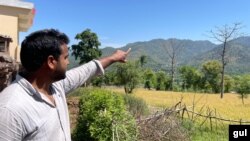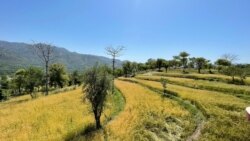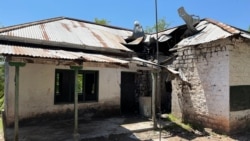Conflict-wary villagers have resumed economic and social activities in the scenic Battal valley in Pakistan-administered Kashmir, about three kilometers from Indian army posts set up on ridges directly overlooking a population of about 30,000.
It has been more than two months since the guns have fallen silent after the reinstitution of an 18-year-old cease-fire between India and Pakistan on their de facto Kashmir frontier.
Known as the Line of Control or LoC, the 740-kilometer military line splits the disputed Himalayan region between the nuclear-armed neighbors, with both claiming all of it.
The surprise late-February truce has effectively halted years of frequent exchanges of artillery, mortars and small arms between Indian and Pakistani militaries, badly fraying civilian lives on both sides in the last three years.
“Life before the cease-fire was extremely miserable, particularly for elderly people like us,” lamented Khurshid Bibi, a 69-year-old woman.
The frequent exchange of fire would erupt early in the morning and at times would continue relentlessly for 10 to 12 hours, she said. “We would run for safety, often having no food until the violence would subside. We feel relieved now and wish this stability is permanently sustained.”
Villagers told VOA the violence would inflict casualties, including on their valuable livestock, cause damage to property and crops, or prevent their timely harvesting and cultivation.
Residents said they are now holding rituals and social activities free of any fear of coming under fire. Health facilities have reopened but education activities remain suspended in the whole of Pakistani-ruled Kashmir like the rest of Pakistan to prevent the spread of the coronavirus pandemic.
Pakistani military officers said that a “peaceful environment" had ensued the cease-fire, having “a very positive psychological” effect on the people and providing “a sense of security for not losing their own or their loved ones’ lives and limbs.”
Kashmir has sparked two of the three wars between nuclear armed India and Pakistan since both the countries gained independence from Britain in 1947. The territorial dispute remains at the heart of bilateral political and military tensions.
Major-General Wajid Aziz, the top regional Pakistani military commander, told reporters on an army-arranged visit to the Battal sector there had been “no significant” cease-fire violations since the truce went into effect two months ago.
“We are hopeful this current cease-fire continues, sustains and paves the way for further negotiations,” Aziz said.
Villager Afzal Ahmed, 30, while pointing to the Indian posts on hilltops near his home said while he and his family have survived the shelling, they lost their livestock, a crucial source of livelihood for people in the area.
“As soon as the cease-fire was announced, I bought these two buffalos so I could resume selling dairy products,” Ahmed said, standing in a small ready-to-harvest wheat field adjacent to his house.
Bilateral tensions dangerously escalated after Indian Prime Minister Narendra Modi’s Hindu nationalist government revoked the semiautonomous status of Indian-administered majority-Muslim Kashmir and declared it a union territory in August 2019.
Pakistan denounced the action and downgraded all ties with India, saying it would do so until the neighbor reversed its Kashmir-related actions.
Islamabad said the Indian actions violated a longstanding United Nations resolution, which recognizes the region as a disputed territory.
New Delhi rejected the objection as an interference in its internal affairs but the ensuing months witnessed intense clashes between the Indian and Pakistani militaries along the Kashmir LoC, causing hundreds of civilian and combat casualties on both sides.
India stepped up long-running allegations that Pakistan was sending infiltrators across the frontier, while Pakistani Prime Minister Imran Khan relentlessly slammed in domestic and international speeches his Indian counterpart, Narendra Modi for stoking Hindu nationalist sentiment against Muslims in India.
Gen. Aziz said about 1.5 million people live along the frontier on the Pakistani side and nearly 30,000 families are directly vulnerable to the Indian fire.
The escalation in the conflict in recent years, he said, prompted the army to help build more than 3,000 family-specific and community bunkers to enable the vulnerable population to seek shelter. But the cease-fire has rendered those bunkers unneeded for now, say villagers.
Mutual tensions have gradually eased since the February truce.
Highly-placed official sources in Islamabad tell VOA the reinstatement of the 2003 cease-fire and recent exchanges of goodwill gestures between Pakistani and Indian leaders stemmed from months of ongoing backchannel peace negotiations.
The sources asserted New Delhi proposed the wide-ranging dialogue between intelligence officials of the two countries a year ago to ease tensions and discuss outstanding disputes, including Kashmir, and Islamabad responded positively.
Last week Pakistan offered to provide essential medical relief supplies to India, which is in the grips of a devastating coronavirus surge and struggling to meet critical hospital needs, including medical oxygen. Indian officials have not yet responded to the offer.
However, critics and residents of Pakistani-ruled Kashmir remain skeptical whether the fledgling cease-fire would hold for long and whether it would lead to a formal, wider peace, citing past experiences and deeply-rooted enmity between the two rival countries.
“It has brought a partial relief to the lives of our people here. But we remain fearful that hostilities could erupt at any time, as we have witnessed in the past,” said Wasim Ahmed Khan, an information technology specialist.
Khan, 42, said he works in Saudi Arabia but came back home on leave after the cease-fire announcement to help his family and parents in the rebuilding process.
"We urge them [Pakistan and India] to use this temporary positive step to find a permeant solution to this problem in line with the wishes of Kashmiri people on both sides,” Khan insisted.











